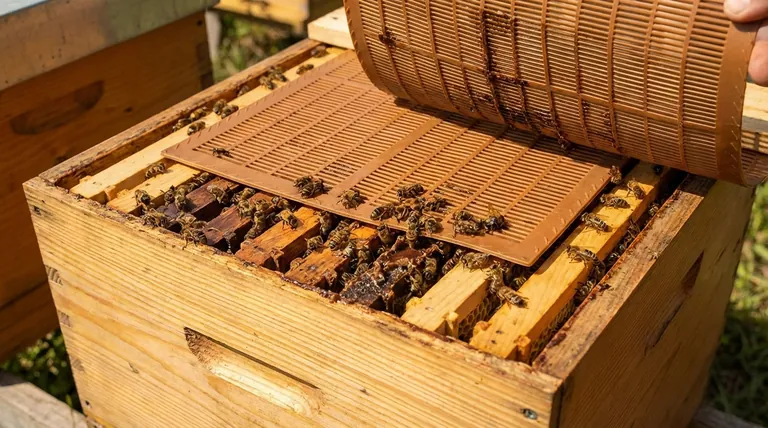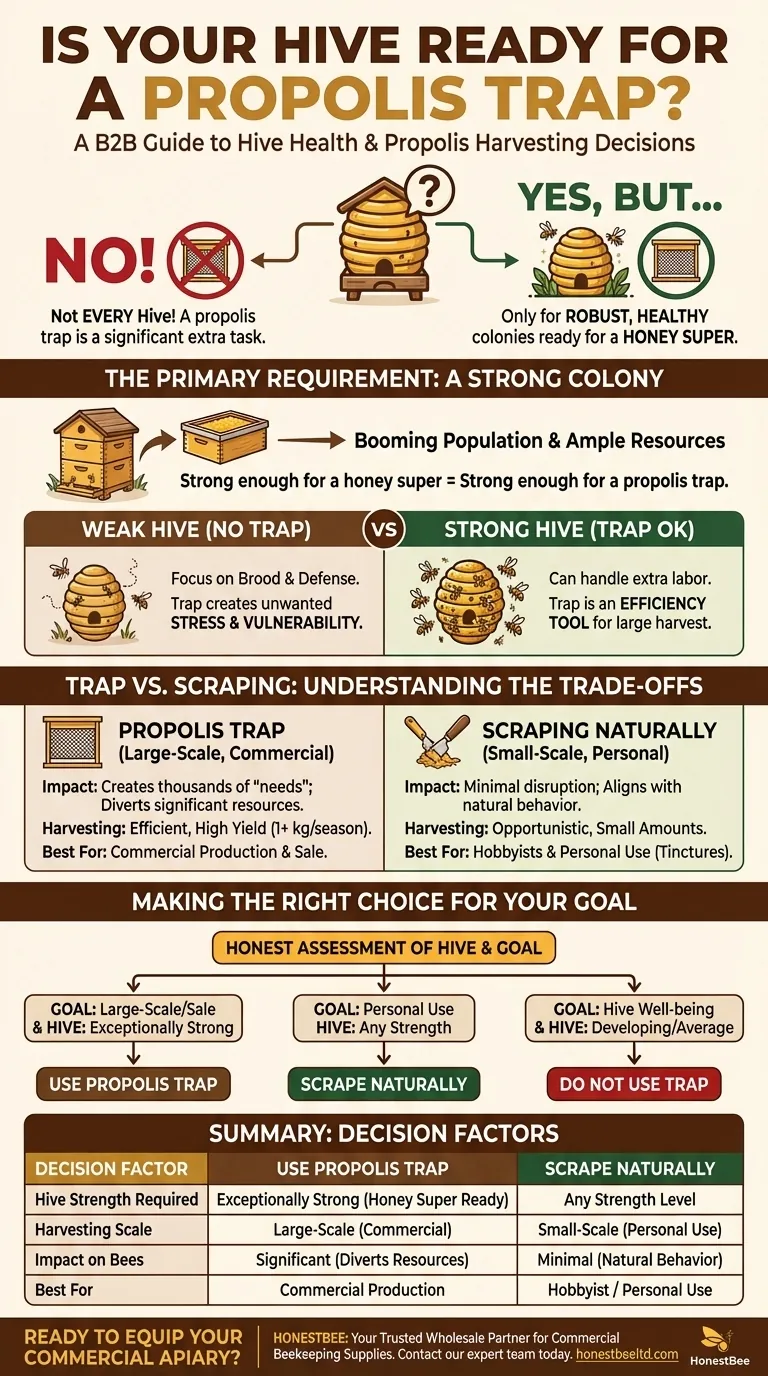No, not just any hive should have a propolis trap. While a trap can be placed on a standard hive, it is crucial that the colony is strong, healthy, and thriving. Adding a trap creates a significant amount of extra work for the bees, and only a robust population can handle this additional task without compromising the hive's overall health and productivity.
The decision to use a propolis trap is not about hive compatibility, but about hive strength and your specific harvesting goals. A trap is an efficiency tool for significant collection, not a standard component for every beehive.

Is Your Hive Ready for a Propolis Trap?
A propolis trap is a specialized screen or mat with small gaps, placed at the top of the hive. Bees, in their instinct to seal drafts and cracks, will fill these gaps with propolis, allowing you to harvest it cleanly and efficiently. However, this is a deliberate diversion of the colony's resources.
The Primary Requirement: A Strong Colony
A propolis trap should only be added to a hive that is booming with population and has ample resources. A weak or struggling hive needs to focus all its energy on core tasks like brood-rearing, foraging, and defense.
Asking a weak colony to also produce a large amount of propolis to fill a trap can stress it further, potentially setting it back or making it more vulnerable to pests and disease.
The "Honey Super" Rule of Thumb
A reliable indicator of a hive's strength is its readiness for a honey super. A super is an extra box added to the hive to give bees space to store surplus honey.
If your hive has a large enough population and nectar is flowing to the point where you need to add a honey super, it is generally considered strong enough to handle a propolis trap. This indicates the bees have a surplus of workers and resources beyond their basic needs.
Understanding the Trade-offs and Alternatives
Using a propolis trap is a specific choice with clear consequences. It is essential to understand both the impact on the hive and the alternative methods for collection.
The Impact on the Hive
Bees produce propolis on an as-needed basis to seal cracks, waterproof surfaces, and create an antimicrobial barrier within the hive. It is not stored like honey or pollen.
A trap creates thousands of "needs" at once. While a strong hive can manage this, it is an unnatural demand that diverts worker bee labor and resources from other tasks.
The Alternative: Harvesting by Scraping
For beekeepers who only need a small amount of propolis for personal use, such as for making tinctures, a trap is often unnecessary.
You can easily collect sufficient amounts by simply scraping it from hive components during regular inspections. Propolis builds up naturally on frame edges, inner covers, and in the corners of super boxes. This method is far less invasive and aligns well with natural beekeeping practices.
Trap vs. Scraping: A Matter of Scale
The choice comes down to your goal. A propolis trap is an agricultural tool designed for efficient, large-scale harvesting, with yields potentially reaching over a kilogram per season under ideal conditions.
Scraping is an opportunistic method suitable for hobbyists who value small amounts of propolis with minimal hive disruption.
Making the Right Choice for Your Goal
To decide whether to use a propolis trap, evaluate your hive's health and your own intentions.
- If your primary focus is harvesting propolis for sale or extensive use: A propolis trap is the most efficient method, but only if your hive is exceptionally strong and ready for a honey super.
- If your primary focus is personal use or small-batch preparations: Simply scraping propolis during regular hive maintenance is sufficient, less invasive, and requires no special equipment.
- If your primary focus is the well-being of a developing or average-sized hive: Do not use a propolis trap, as it will add unnecessary stress to the colony.
Ultimately, your role is to support your bees, and choosing the right tool for the job begins with an honest assessment of their strength.
Summary Table:
| Decision Factor | Use a Propolis Trap | Scrape Naturally |
|---|---|---|
| Hive Strength Required | Exceptionally strong (ready for a honey super) | Any strength level |
| Harvesting Scale | Large-scale (1+ kg per season) | Small-scale (for personal use) |
| Impact on Bees | Significant; diverts resources | Minimal; aligns with natural behavior |
| Best For | Commercial propolis production | Hobbyist beekeepers, personal use |
Ready to equip your commercial apiary for success?
Whether you're planning for large-scale propolis harvesting or need reliable supplies for strong, productive hives, HONESTBEE is your trusted wholesale partner. We supply commercial apiaries and beekeeping equipment distributors with the high-quality tools needed for efficient, healthy beekeeping operations.
Contact our expert team today to discuss your specific needs and discover how our wholesale-focused solutions can support your business's growth and productivity.
Visual Guide

Related Products
- 8 Frame and 10 Frame Propolis Trap Collector Screen for Propolis Collection
- Professional Galvanized Hive Strap with Secure Locking Buckle for Beekeeping
- Reusable Clear Small Hive Beetle Traps for Beehives Beetle Trapping Tools
- Reusable Aluminium Beetle Trap for Small Hive Beetles Silver Bullet
- Langstroth Screen Bottom Board for Beekeeping Wholesale
People Also Ask
- How should you open the hive during an inspection? Master the Calm, Low-Stress Technique
- What method is used to collect venom from honey bees? A Guide to Modern, Non-Lethal Extraction
- What are the considerations when making propolis tinctures? A Guide to High-Quality Extracts
- What are the differences between bottom-mounted and front-mounted pollen traps? Choose the Right Tool for Your Harvest.
- Do beekeepers have to use a propolis trap? A Guide to Harvesting Bee Glue Efficiently



















